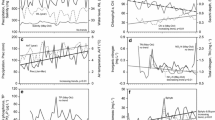Abstract
The ecological risk of changes in the content of essential polyunsaturated fatty acids (PUFAs) in plankton of lakes due to global warming is assessed. The analyzed hazards are temperature, dissolved phosphorus and nitrogen, and the phyto- and zooplankton structure. The main risks are related not only to the temperature increase, but indirect effects of warming. The critical link in PUFA risk assessment is the phytoplankton structure due to the particularly favorable growth conditions for cyanobacteria in nutrient rich waters in shallow lakes and reservoirs.
Similar content being viewed by others
References
Schneider, P. and Hook, S.J., Space Observations of Inland Water Bodies Show Rapid Surface Warming Since 1985, Geophys. Res. Lett., 2010, vol. 37, no. 24, p. L22405.
McCarthy, J.J., Canziani, O.F., Leary, N.A., Dokken, D.J., and White, K.S., Climate Change, Cambridge University Press, 2001.
Moore, M.V., Hampton, S.E., Izmest’Eva L.R., Silow E.A., Peshkova E.V., and Pavlov B.K. Climate Change and the World’s Sacred Sea — Lake Baikal, Siberia, BioScience, 2009, vol. 59, pp. 405–417.
Maazouzi, C., Masson, G., Izquierdo, M.S., and Pihan, G.C., Midsummer Heat Wave Effects on Lacustrine Plankton: Variation of Assemblage Structure and Fatty Acid Composition, J. Thermal Biology, 2008, vol. 33, no. 5, pp. 287–296.
Gladyshev, M.I., Arts, M.T., and Sushchik, N.N., Preliminary Estimates of the Export of Omega-3 Highly Unsaturated Fatty Acids (EPA + DHA) from Aquatic To Terrestrial Ecosystems, Lipids in aquatic ecosystems. New York: Springer, 2009, pp. 179–209.
Gladyshev, M.I., Semenchenko, V.P., Dubovskaya, O.P., Fefilova, E.B., Makhutova, O.N., Buseva, Zh.F., Sushchik, N.N., Baturina, M.A., Razlutskij, V.I., Lepskaya, E.V., and Kalacheva, G.S., Effect of Water Temperature on the Content of Essential Polyunsaturated Fatty Acids in Freshwater Zooplankton, Doklady Biochemistry and Biophysics, 2011, vol. 437, pp. 57–59.
Arts M., Ackman R.G., and Holub B.J. Essential fatty acids in aquatic ecosystems: a crucial link between diet and human health and evolution Can. J. Fish. Aqu. 2001. vol. 58. pp. 122–137.
Anonymous. Guidelines for Ecological Risk Assessment, Washington, DC. 1998.
Shlyakhter, A., Valverde, L.G., and Wilson, A.Jr.R., Integrated Risk Analysis of Global Climate Change, Chemosphere, 1995, vol. 30, no. 8, pp. 1585–1618.
Jeppesen, E., Eutrophication and Global Warming — the Key Environmental Issues for Small Lakes and Ponds in the Next 25 Years, Environmental Future of Aquatic Ecosystems. Switzerland: ETH Zurich, 2003.
Feuchtmayr, H., Moran, R., Hatton, K., Connor, L., Heyes, T., Moss, B., Harvey, I., and Atkinson, D., Global Warming and Eutrophication: Effects on Water Chemistry and Autotrophic Communities in Experimental Hypertrophic Shallow Lake Mesocosms, J. Applied Ecology, 2009, vol. 46, pp. 713–723.
Matzinger, A., Schmid, M., Veljanoska-Sarafiloska, E., Patceva, S., Guseska, D., Wagner, B., Mller, B., Sturm, M., and Wuest, A., Eutrophication of Ancient Lake Ohrid: Global Warming Amplifies Detrimental Effects of Increased Nutrient Inputs, Limnol. Oceanogr., 2007, vol. 52, no. 1, pp. 338–353.
Muller-Navarra, D.C., Brett, M.T., Park, S., Chandra, S., Ballantyne A.P., Zorita E., and Goldman C.R. Unsaturated fatty acid content in seston and trophodynamic coupling in lakes, Nature, 2004, vol. 427, pp. 69–72.
Ecker, M.D. and Janssen, A., Statistical Analysis of Water Quality Data from Lake Casey and Silver Lake / UNI Summer Lakes Study Report, 2000, pp. 1–6.
Konopka, A. and Brock, T.D., Effect of Temperature on Blue-Green Algae (Cyanobacteria) in Lake Mendota, Applied and Environmental Microbiology, 1978, vol. 36, no. 4, pp. 572–576.
Hiroyuki, I., Kwang-Hyeon, C., Maiko, K., and Shin-Ichi, N., Temperature-Dependent Dominance of Microcystis (Cyanophyceae) Species: M. Aeruginosa and M. Wesenbergii, J. Plank. Res, 2009, vol. 31, no. 2, pp. 171–178.
Mitrakhovich, P.A., Samoilenko, V.M., Karatashevich, Z.K., Svirid, A.A., Kozlov, E.A., Korolev, G.N., and Papko, N.A., Ekosistema vodoema-okhladitelya Lukoml’skoi GRES, in Pravo i ekonomika (TRANSLATION), Minsk, 2008.
Xie, L.Q., Xie, P., and Tang, H.J., Enhancement of Dissolved Phosphorus Release from Sediment To Lake Water by Microcystis Blooms — An Enclosure Experiment in a Hyper-Eutrophic, Subtropical Chinese Lake, Environ. Pollut., 2003, vol. 122, no. 3, pp. 391–399.
Sushchik, N.N., Rol’ nezamenimykh zhirnykh kislot v trofometabolicheskikh vzaimodeistviyakh presnovodnykh ekosistem, Zh. Obshch. Biol., 2008, vol. 69, no. 4, pp. 299–316.
Burns, C.W., Brett, M.T., and Schallenberg, M.A., A Comparison of the Trophic Transfer of Fatty Acids in Freshwater Plankton by Cladocerans and Calanoid Copepods, Freshwater Biology, 2011, vol. 56, no. 5, pp. 889–903.
Schindler, D.E., Rogers, D.E., Scheuerell, M.D., and Abrey, C.A., Effects of Changing Climate on Zooplankton and Juvenile Sockeye Salmon Growth in Southwestern Alaska, Ecology, 2005, vol. 86, pp. 198–209.
Visconti, A., Manca, M., and De Bernardi, R., Eutrophication-Like Response To Climate Warming: An Analysis of Lago Maggiore (N. Italy) Zooplankton in Contrasting Years, J. Limnol, 2008, vol. 67, no. 2, pp. 87–92.
Sushchenya, L.M., Semenchenko, V.P., and Galkovskaya, G.A., Vidovoe raznoobrazie pelagicheskogo zooplanktona ozer raznogo tipa, Dokl. Akad. Nauk Belarusi, 2001, vol. 46, no. 6, pp. 83–85.
Brucet, S., Dani, B., Quintana, X.D., Jensen, E., Nathansen, L.W., Trochine, C., Meerhoff, M., Gascn, S., and Jeppesen, E., Factors Influencing Zooplankton Size Structure at Contrasting Temperatures in Coastal Shallow Lakes: Implications for Effects of Climate Change, Limnol. Oceanogr., 2010, vol. 55, no. 4, pp. 1697–1711.
Author information
Authors and Affiliations
Corresponding author
Additional information
Original Russian Text © V.P. Semenchenko, 2012, published in Sibirskii Ekologicheskii Zhurnal, 2012, No. 4, pp. 523–528.
Rights and permissions
About this article
Cite this article
Semenchenko, V.P. Assessment of ecological risk in change of content of essential poluyunsaturated fatty acids in plankton of lakes during global warming. Contemp. Probl. Ecol. 5, 386–390 (2012). https://doi.org/10.1134/S1995425512040129
Published:
Issue Date:
DOI: https://doi.org/10.1134/S1995425512040129




